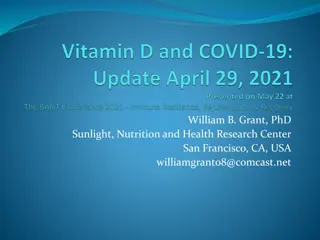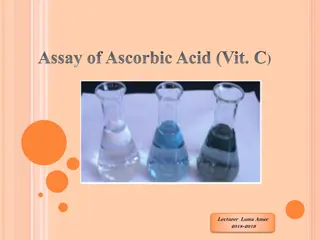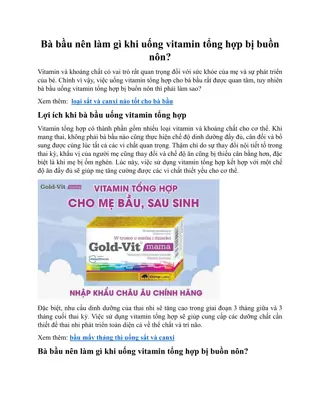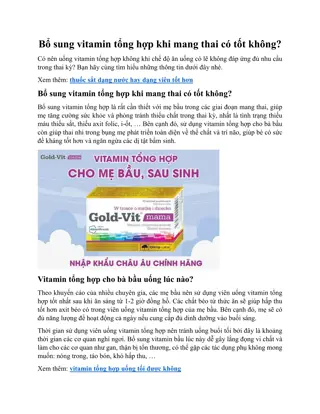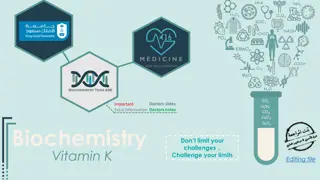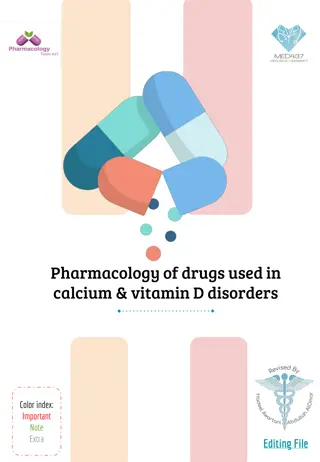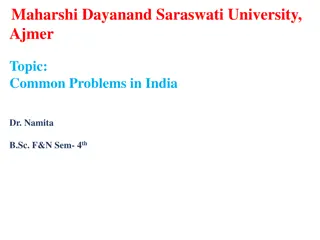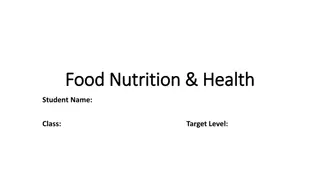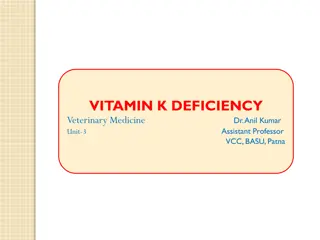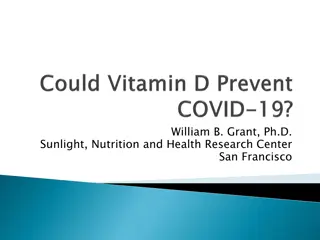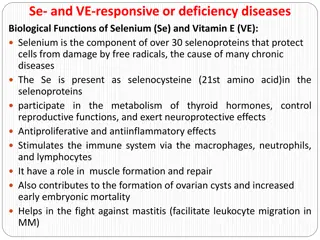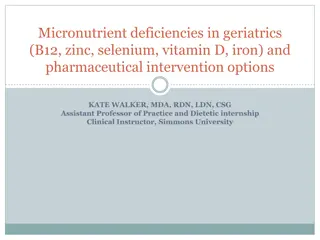Vitamin A: Essential Micronutrient for Optimal Health
Vitamins are crucial for normal cell function and overall health. Learn about the importance of Vitamin A, its sources, forms, and role in maintaining healthy mucosal membranes, immunity, and vision. Discover the difference between fat-soluble and water-soluble vitamins, and explore the benefits of carotenoids in plant foods.
Download Presentation

Please find below an Image/Link to download the presentation.
The content on the website is provided AS IS for your information and personal use only. It may not be sold, licensed, or shared on other websites without obtaining consent from the author.If you encounter any issues during the download, it is possible that the publisher has removed the file from their server.
You are allowed to download the files provided on this website for personal or commercial use, subject to the condition that they are used lawfully. All files are the property of their respective owners.
The content on the website is provided AS IS for your information and personal use only. It may not be sold, licensed, or shared on other websites without obtaining consent from the author.
E N D
Presentation Transcript
By- Dr Aamena Zaidi Assistant Professor Department of Nutrition Science School of Health Science
VITAMINS What is a Vitamin? Vitamins are a group of essential nutrients that the human body requires for normal cell function, development and growth, and for maintaining overall proper health. These are organic compounds that are present in several food items in small quantities. Human beings need to consume all types of vitamins from these eatables to ensure nutrient balance as our bodies do not naturally synthesise them. Also, a deficiency of these nutrients can lead to numerous health problems, ranging from mild to fatal.
DIFFERENCE BETWEEN FAT SOLUBLE AND WATER SOLUBLE VITAMINS FAT SOLUBLE VITAMINS Soluble in fat. Stored in liver. Requires carrier protein. Absorbed along with other lipids. Toxicity( hypervitaminosis) may occur. Deficiency occurs only when stores are depleted. E.g. A,D,E,K WATER SOLUBLE VITAMINS Soluble in water. Excreted in urine. No requirement of carrier protein Absorption is simple. Unlikely,since excess is excreted. Deficiency manifests rapidly as there is no storage. E.g B complex and vit C.
INTRODUCTION Vitamin A was discovered in1909 and its chemical name is retinol. Vitamin A is an essential fat-soluble micronutrient required for normal growth development, maintenance of healthy mucosal membranes, reproductive health, immunity, and vision, especially for dark adaptation. Vitamin A occurs only in foods of animal origin.Vitamin A activity is possessed by carotenoids found in plants.Hence carotenoids are called provitamnins A.
TYPES OF VITAMIN A The two main forms of vitamin A in the human diet are preformed 1. Vitamin A (retinol, retinyl esters) 2. Provitamin A carotenoids (such as beta-carotene that are converted to retinol). Preformed vitamin A comes from 1.Animal products 2.Fortified foods 3.vitamin supplements.
Carotenoids are found naturally in plant foods. There are other types of carotenoids found in food that are not converted to vitamin A but have health-promoting properties; these include- 1.Lycopene 2.Lutein 3.Zeaxanthin.
1) It is a primary alcohol containing beta-ionone ring. 2) The side chain has two isoprenoid units,four double bonds and one hydroxyl group. 3) Retinols present in animal tissues as retiny ester with long chain fatty acids.
1)This is an aldehyde form obtained by the oxidation of retinol. 2)Retinal and retinol are interconvertible.
1.)This is produced by the oxidation of retinal. 2.)Retinoic acid cannot give rise to the formation retinal or retinol.
1.)This is present in plant foods. 2.)It is cleaved in the intestine to produce two moles of retinal;but it may produce only one in biological system.
1.)All the compounds with vitamin a activity are reffered as retinoids. 2.)They are poly-isoprenoid compounds having beta-iononering system. 3.)The retinal may be reduced to retinol by retinal reductase and it is reversible. 4.)Retinal is oxidized to retinoic acid,which cannot be converted to the other forms.
ABSORPTION OF VITAMIN A Dietary retinyl esters are hydrolyzed by pancreatic or intestinal brush border hydrolases,releasing retinol and free fatty acids. Beta-carotene is cleaved by di-oxygenase of intestinal cells to release 2 moles of retinal. Retinal is reduced to retinol by an NADH or NADPH dependent retinal reductase present in intestinal mucosa.
In the intestinal mucosal cells,retinol is reesterified to long chain fatty acids,incorporated into chylomicrons and transferred to the lymph Intestine is the major site of absorption. Absorption is along with other fats and requires bile salts. In biliary tract obstruction and steatorrhoea,vitamin A absorption is reduced. The retinol esters of chylomicrons are taken up by the liver and stored (As retinol palmitate)
Vitamin A deficiency is rare in western countries but may occur.conditions that interfare with normal digestion can lead to vitamin A malabsorption such as celiac disease,crohn s disease,cirrhosis,alcoholism and cystic fibrosis.also at risk are adults and children who eat a very limited diet due to poverty or self-restriction.mild vitamin A deficiency may cause fatigue,susceptibility to infections and infertility.
The following are signs of a more serious deficiency- 1) XEROPHTHALMIA, a severe dryness of the eyes that if untreated can lead to blindness. 2)NYCTALOPIA or NIGHT BLINDNESS. 3)Keratomalacia 4)Bitot s spot. 5)skin becomes rough,dry and scaly.This condition is known as toad s skin. TOXICITY Vitamin A toxicity may be more common in the U.S than a deficiency,due to high doses of preformed vitamin A (retinol) found in some supplements.
Vitamin A is also fat-soluble,meaning that any amount not immediately needed by the body is absorbed and stored in fat tissue or the liver.If too much is stored, it can become toxic. The tolerable upper intake of 3,000 mcg of performed vitamin A, more than three times the current recommended daily level , is thought to be safe. However,there is some evidence that this much preformed vitamin A might increase the risk of bone loss,hip fracture or some birth defects. Another reason to avoid too much preformed vitamin A is that it may interfere with the beneficial actions of Vitamin D.
Signs of toxicity include the following- 1)Vision changes such as blurry sight. 2)Bone pain. 3)Nausea and vomiting. 4)Dry skin. 5)Sensitivity to bright light like sunlight.


